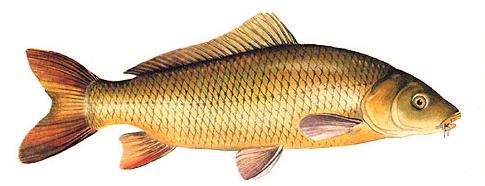
Since time immemorial the Common Carp has ranked among the
most popular fishes not only in Europe, but also on other continents, where it has been
introduced. The original wild Common Carp occurs only in the Danube and in the river Tisa.
The shape of its body is always low and elongate, its home
territory being the waters emptying into the Black, Caspian and Aral Seas and perhaps
western Europe, the second centre being the territory of the Pacific coast from the Amur
to Burma. It has also been introduced, for example, in Australia and New Zealand.
The Carp is an exquisite fish with a perfectly constructed
muscular body, whose dorsal line forms a continuous curve. Considerable deviations can be
found in various cultured varieties in which the back rises steeply beyond the head. The
head is relatively small, asymmetrically tapered, with a small protrusible mouth provided
with strong lips and four barbels. The mouth has no teeth and is capable of picking up
even coarse food.
The carp has three rows of teeth arranged in the 1,1,3-3,1,1
pattern. Below them there is a callous pad which facilitates the crushing of food. The
eyes are placed relatively high on the head. The gill covers are smooth, terminating in a
leathery rim with which the carp can close its gill slits in adverse conditions (e.g. in
mud). The external side of the first branchial arch bears 21-29 gill rakers. Regarding the
internal organs, mention should be made of the simple alimentary canal which has no
stomach and is surrounded by the long lobes of liver. In females the body cavity also
contains the ovaries.
The fins of the Carp are regular and symmetrically
distributed. The large dorsal fin has 3 or 4 hard and 18-20 soft rays, as a rule. The
number of soft rays, however, can vary from 15-17 (rarely) to 21 or 22. The pectoral fins
growing just below the gills have one hard and 15 or 16 soft rays. The ventral fins
situated in about the middle of the length of the body have 2 hard and 8 or c) soft rays.
The trapezoidal anal fin has 3 hard and 5 soft rays, the wide, forked caudal fin
comprising '7-'9 soft rays. The body of the original Common Carp is covered with scales
arranged in regular rows and not very well grown into the skin. The lateral line has 30
--4�0 scales, with 5 or 6 rows of scales above and 5 or 6 rows below it. The colouration
of the Carp is rather variable, adaptable to various situations and the character of the
bottom of the ponds where it lives.
The Carp is a thermophilic, gregarious fish dwelling mostly
at the bottom of ponds. It thrives best in well warmed waters at lower elevations. It can
adapt to coarser conditions which, however, impair its growth. According to the weather it
does not only stay at the bottom, but sometimes rises to the surface where it basks on
warm, sunny days. It is very shy and cautious. It attains sexual maturity in the third or
fourth years, earlier in warmer climates.
The spawning season begins at the end of April and can extend
to as late as June depending on the temperature of the water, which must be between 16 and
18�C. The female seeks shallow, overgrown places where she deposits the eggs, usually
about 20 ins below water level. The eggs are 1.5 mm in diameter, their number depending on
the weight of the fish, 50-100 thousand eggs being 1 lb of its weight. A female weighing 8
or 10 lbs can lay 600-900 thousand eggs. In water at 16�C the eggs hatch in 5 days. If
the water temperature is higher, the hatching period is reduced to 3 days. The embryo, 5
or 6 mm long, feeds on its yolk sac for the first two or three days. The sac completely
disappears after 8-10 days. After this period the young fishes feed on smaller plankton,
particularly zooplankton. Later on they begin to eat larvae living at the bottom of
shallow water, gradually including worms and insects in their diet. We can often also find
fine algae in their alimentary canal. With a rise of water temperature also the intake of
food increases, becoming greatest at a temperature of 17 - 25�C. As the water temperature
is lowered, so the intake of food becomes lower. At a temperature of 2 -5 �C the carp
takes no natural food at all, gathering at the bottom in selected places to hibernate.
(The Carp has no demanding oxygen requirements. In winter 3 cm3 per litre of water is
sufficient, in summer the requirement rises to a maximum of 3 or 4 to 7 3 of oxygen per
litre.)
The growth of the Carp is very rapid, particularly in
favourable habitats. In the first year the young reach a weight of 5 oz -1 lb, in the
second 5 ozs - 2 lbs, in the third 12 ozs - 4 lbs. In Java, with a mean annual temperature
of 25- 27�C, the Carp grows 3 to 3 times as quickly as in Central Europe. In Central
European conditions the Carp achieves an average length of 20-24 ins and a weight of 10
lbs, the maximum being 40 ins and 60-65 lbs.
Its rapid growth, tasty flesh, good reproductive ability and
modest requirements have led to the Carp's becoming the staple fish of warm water
fisheries. This process began in the 15th-16th century when the Carp was domesticated and
various pond forms' were developed which can be identified according to their squamation.
We distinguish four basic forms, the Scale Carp, the Mirror Carp, the Band Carp and the
Leather Carp.